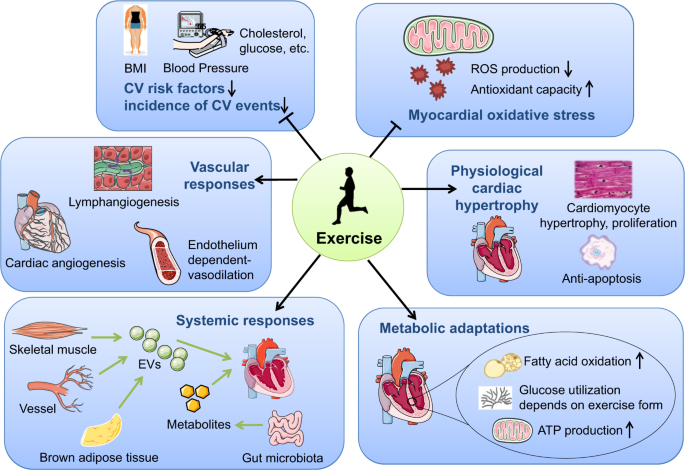
Cardiovascular Exercise: Benefits, Types, and Guidelines for Cardio Workouts
Cardiovascular exercise, often referred to as cardio or aerobic exercise, involves activities that increase your heart rate and breathing rate. Regular cardiovascular exercise offers a wide range of health benefits and is an essential component of a balanced fitness routine. Here’s a detailed overview of its benefits, types, and guidelines:


Benefits of Cardiovascular Exercise:
Improves Heart Health: Cardio workouts strengthen the heart muscle, improving its efficiency and reducing the risk of heart disease.
Enhances Lung Function: Regular cardio improves lung capacity and oxygen delivery to the body’s tissues.
Aids in Weight Loss: Cardio burns calories, helping to create a calorie deficit for weight loss when combined with a healthy diet.
Boosts Mood: Cardio releases endorphins, improving mood and reducing stress, anxiety, and depression.
Increases Endurance: Over time, cardiovascular fitness improves, allowing you to perform daily activities more efficiently without fatigue.
Reduces Chronic Disease Risk: Regular cardio can lower the risk of chronic diseases like diabetes, stroke, and certain types of cancer.

Types of Cardiovascular Exercise:
Low-Impact Cardio: Activities like walking, swimming, or using an elliptical machine provide cardiovascular benefits without stressing the joints.
High-Impact Cardio: Running, jumping rope, or high-intensity interval training (HIIT) are more intense forms of cardio that can increase calorie burn and improve fitness.
Group Fitness Classes: Dance-based classes like Zumba, cycling, or step aerobics are enjoyable ways to get cardiovascular exercise.
Sports: Activities such as tennis, basketball, and soccer can provide a fun way to improve cardiovascular fitness.

Guidelines for Cardio Workouts:
Frequency: Aim for at least 150 minutes of moderate-intensity cardio exercise per week, or 75 minutes of vigorous-intensity exercise, spread throughout the week.
Intensity: Moderate-intensity cardio should make you breathe harder but still allow you to talk comfortably. Vigorous-intensity cardio will make you breathe rapidly and make it challenging to hold a conversation.
Duration: Workouts should last at least 10 minutes to provide cardiovascular benefits.
Progression: Gradually increase the duration or intensity of your workouts as your fitness improves.
Warm-Up and Cool Down: Always start with a warm-up to prepare your body and end with a cool-down to gradually bring your heart rate back to normal.
Safety: Choose activities that you enjoy and that match your fitness level. If you have any health concerns or are new to exercise, consult with a healthcare professional before starting a new exercise program.
Incorporating cardiovascular exercise into your routine can have profound benefits for your overall health and well-being. Experiment with different activities to find what you enjoy most and can sustain over time.




